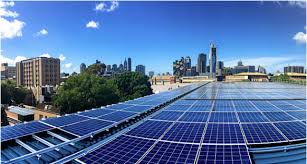
Researchers at the University of Melbourne will use new materials to try to tap more efficiency from solar panels.
Enhancing silicon solar cell efficiencies could lead to a drop in the cost per Watt of delivered electricity of up to 20 per cent.
Excess energy in high energy photons is normally lost as heat in solar cells but a team led by Research Group Leader, Dr David Jones, will identify better ways to use surplus energy, by getting more from each photon.
“From ultra-violet to infra-red solar panels use light to generate electricity, however only the red light is used efficiently with 60 to 80 per cent of the energy in yellow, green or blue light lost as heat in solar cells,” Dr Jones said. “We need simple, cost effective ways to recover the lost energy and turn it into electricity. New materials using quantum coupled states provide a route to use the energy in green or blue light to generate twice the power. By increasing the efficiency of solar cells by just five per cent we can reduce the cost of delivered energy by 20 per cent.”
The work is a collaboration with the University of Queensland and the Australian ³Ô¹ÏÍøÕ¾ University and has been supported by a $1.29 million grant from the Australian Renewable Energy Agency (ARENA), announced recently.
The grant will allow the development of new materials to maximise the efficiency gain.
Dr Jones said new materials will be synthesised at the University of Melbourne, while detailed spectroscopic characterisation of the materials at the University of Queensland, and incorporation into silicon solar cells at the will be in collaboration with the silicon solar cell group at the Australian ³Ô¹ÏÍøÕ¾ University.
“The ARENA funding will allow us to bring together three key groups to demonstrate for the first time that we can use these quantum coupled states to show real impact and not just a laboratory curiosity,” said Dr Jones.
Current solutions to harvest the excess energy involve costly highly engineered solutions, such as stacking three to four solar cells to harvest parts of the solar spectrum. This new research offers the potential of a simple solution using new materials that can be printed onto a low-cost silicon solar cell.
The new organic semiconductor materials developed in Dr Jones’ laboratory use the generation of quantum coupled states to share this energy between two molecules, or parts of the same molecule. Electrons are normally paired in these materials and the electron spins can be aligned either in the opposite direction, called a singlet, or in the same direction, called a triplet.
Where the energy of the triplet is half that of the singlet, a process of singlet fission allows the energy to be shared between two triplets, effectively enabling generation of two electron/hole pairs from a single photon. Although the process of singlet fission has been known as a curiosity for some time, recent work within Dr Jones’ research group has shown a new class of materials that should enable this to be translated to real systems.
Professor Paul Burn, an ARC Australian Laureate Fellow from the School of Chemistry and Molecular Biosciences at the University of Queensland said consumers stand to benefit from the work of the three universities.
“Simple methods for enhancing silicon solar cell efficiencies could have real cost benefits over the complex engineering solutions being currently pursued.”








